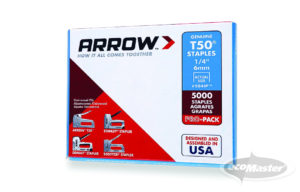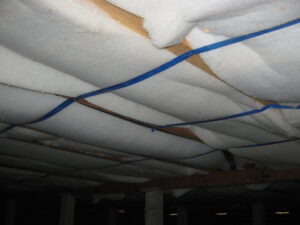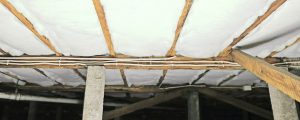Stapling insulation is the best way to ensure your underfloor insulation withstands the test of time. While other bulk insulations like fibreglass has loose fibres that won’t hold a staple, our polyester insulation’s strong, heat-bonded fibres are perfect.
Stapling secures the insulation forever, pushing it firmly against the floorboards so it can do what it does best. Stapling also holds the insulation in place to prevent rodents from nesting between the floorboards and the insulation.
We only recommend stapling insulation because we want you to get the best value for your time and money. You don’t want the sad and saggy plastic strapping disaster in this picture to happen to you!

What Stapler Should I Use?
When stapling insulation under a floor, there are few things you need to know to ensure your safety and the quality of your job.
It is absolutely crucial that you only use electric or battery operated staplers when working under your floor. These types of staplers are double insulated, which means you can’t be electrocuted if you accidentally staple a wire under the floor.
ALWAYS use an RCD
When using a staple gun that plugs into a power source, we recommend working with a portable Residual Current Device (RCD) which is an effective add-on safety switch. It cuts the power supply instantly in the instance of an electrical fault of any kind.
Our Preferred Powered Stapler
ecoMaster has used tons of staplers and staples over the years. The stapler that our installers LOVED is the Proline stapler. These are not available as the manufacturer has stopped making them. (They didn’t break quickly enough). 🙁
Before switching to the Proline, the teams used the Ozito 8-14mm Staple Nail Gun, which is available in popular hardware stores. In our experience, these staplers work best with Arrow 10mm T50 Staples loading half a clip at a time.
Battery-Operated Cordless Staple Gun
If you have hard wood joists you might find that the Ozito is not quite powerful enough and some people prefer to use a cordless stapler because they don’t have to deal with the cord while working under the floor. We used and now hire out 12V Milwaukee Staplers with Battery and chargers in the Easy Install Kit. (This is for Melbourne customers only as it is pickup and drop back to our office).
WARNING: Remember to leave your power on, even though your stapler is cordless. We’ll tell you more about why it’s safer to leave the power connected below.
Old-fashioned Metal Staple Gun
Never use ordinary metal staple guns when stapling insulation under a floor. These are not insulated and there is a very serious risk of electrocution. This is because the metal stapler is highly conductive and nothing will stop that electricity travelling to your body.
How many staples should I use?
For best results, choose 10mm galvanised staples. 10mm will be sufficient to penetrate even the hardest of hardwood timbers.
Allow 600 to 900 staples per PACK of insulation. We use Arrow 10mm T50 staples available on our webstore in either 1250 or 5000 packs.

Why It’s Safer to Leave the Power On
So, why not just turn off the power? There’s a really good reason why we always leave the power on. Leaving the power connected while you’re insulating a crawl space is the safest thing you can do. Here’s two good reasons why:
- Having lights fitted under your floor helps you work with ease. The better you can see, the less likely you are to interfere with any wiring, pipes, or ducts you have underneath your home.
- Your power supply will tell you straight away if you accidentally staple a wire under the floor. Leaving the power connected means that if you hit a wire, the power will be cut off which is a signal for you to call an electrician to repair it. Doing this will prevent unexpected electrical issues when you finish working, which may result in a serious fire hazard.
And remember, your double-insulated stapler, your portable RCD, and your home’s safety switch will keep you safe from electrocution if you do hit a live wire.
We wish you all the best as you install your polyester underfloor insulation!






